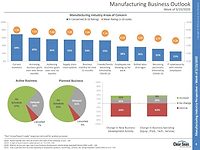Coronavirus Outbreak Takes Its Toll on Global Automotive Industry

As the coronavirus outbreak spread rapidly across the world, the global automotive industry was largely caught unprepared, halting auto businesses not only in China, but also in the United States and across Europe. A major impact of the outbreak has arisen from the disruption of supply chains for auto components, which are primarily manufactured in India and China.
With mobility restrictions expected to continue through a large part of 2020, the automotive industry is anticipated to go through a difficult time, as manufacturers in the automobile market seek ways to resurrect avenues for cash flow after the pandemic is brought back under control.
Key Threats
As the coronavirus spreads, most public events have been cancelled, including those essential to the promotion of the automobile industry, such as motorsports events and auto shows. Further, fluctuations in fuel prices coupled with the event cancellations is likely to result in slowing down auto sales and launches of new vehicles into the market, as manufacturers put projects on hold for a few months or until 2021.
Other factors apart from the coronavirus can also play significant roles in terms of trends in car pricing. Analysts continue to project reduced growth for 2020, which in turn could result in better deals for consumers. The threat of the coronavirus on supply chains is substantial. However, it is one of many factors affecting the global auto industry at the moment.
Car Shopping Figures to Decline for Short Term
Spring and summer are normally some of the most profitable times in terms of car sales. However, with a growing number of people staying home during the pandemic, the auto industry is very likely to suffer the consequences. Regions with higher concentration of coronavirus cases have witnessed a decline of approximately 10 percent in comparison to the same period last year.
As the number of coronavirus cases continues to increase on a daily basis, the extent of damage to the industry is hard to accurately predict. On the other hand, car purchases cannot be delayed for an indefinite period of time. Most car purchases are a matter of necessity. Consequently, car sales figures are likely to recover during the latter half of the year. Further, as the number of unused cars at dealerships continue to go up, manufacturers are expected to provide discounts and other incentives to attract more buyers.
Uncertainties Over Long-Term Effects
Apart from China, the European countries of Spain, Italy and France have faced the brunt of the pandemic. While production is likely to slow down with manufacturing facilities shutting down, the outbreak is unlikely to create major vehicle shortages for consumers.
In terms of long-term strategies, it is important for automobile manufacturers to seek auto component supplies from other regions, apart from the traditional suppliers in China. Diversification of auto component and material suppliers, along with increased rates of domestic production is likely to gain favor as the industry returns to normalcy.
Lack of Backup to China Exposes Cracks
China currently accounts for approximately US $40 Bn in terms of global auto components. With substantial disruptions being reported in the region, major auto manufacturers are now facing a lack of adequate preparedness. Compounded with the effects of the tariff disputes between the United States and China, the high levels of supplies concentrated within China has made the situation worse.
Issues of shorter lead times for incoming auto components and minimal buffer inventories are expected to change the approach taken by players within the auto industry. Decisions in terms of bolstering inventories and optimizing costs in terms of certifying suppliers, and sharing of design data will gain importance owing to the highly competitive environment of the industry.
Limited Inventory Practices Creates Challenge
The fact that most auto component production comes out of China, as well as poor working conditions in the region have been key factors impacting supply chains. The automobile industry is particularly susceptible to risk from unplanned delays and production stoppages.
The common practice of making use of smaller component inventories, and the reliance on regular deliveries at assembly plants is now a key problem that the industry is grappling with. As suppliers are forced to temporarily cease operations, numerous assembly plants also go down along with them, creating major problems for entire product categories.
The lack of alternative sources for components for a situation such as the coronavirus outbreak is a critical challenge. Only a few in the industry have been able to come up with flexible plans to deal with supply chain disruptions.
Electrification Trends to Aid in Mitigating Losses
With the increased level of contagiousness, and concerns over the spread of the virus, particularly in closed, shared spaces, ride hailing and car sharing practices will have a smaller impact on car sales. People are likely to stick to their own vehicles.
Further, the trend of vehicle electrification is not likely to slow down significantly. Strong environment-based regulations continue to push developments at a rapid clip. While manufacturers are concerned about supply chain disruptions for battery cells, the supplies have not gone down substantially so far.
Cost Reduction Initiatives to Remain an Essential Strategy
At present, automobile manufacturers are seeking avenues to minimize operational costs. A key aspect of such measures is likely to include employee layoffs. Currently, the industry employs several million workers, who are in many cases at risk as production units continue to operate in many regions. Consequently, measures of worker safety will also gain importance and will remain an essential factor in the recovery phase, as the pandemic reaches a stage of stability.
In addition, the automotive market currently has substantial levels of liquidity, which minimizes the risk of cash flow shortages. The coronavirus is more of a humanitarian crisis, rather than an economical one. Consequently, leveraging strong performance from extensive human resources, through transparency and safety will be essential towards the road to recovery.
The insights presented in this article are based on Future Market Insights COVID-19 Impact on Automotive Industry.
References
https://www.automotiveworld.com/articles/live-coronavirus-impact-on-the-auto-industry/
https://www.motortrend.com/news/covid-19-coronavirus-automotive-industry-impact-events/
https://hedgescompany.com/blog/2020/03/coronavirus-impact-on-automotive-aftermarket/
Looking for a reprint of this article?
From high-res PDFs to custom plaques, order your copy today!






